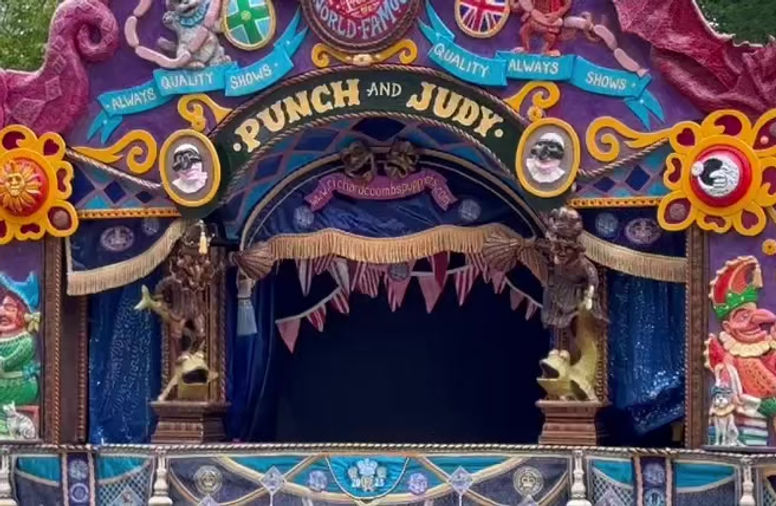



PROFESSOR BUBBLES





Two preliminary sketches for this bubble blowing rod puppet.
Drawings are only ever a rough starting point for me, rather than actual blueprints of a build. So things always change.


Before you explore how he was built, it's nice to see how he looked in performance in the summer of 2025


About twenty years ago I built a bubble blowing duplicate version of my then Joey the Clown.
Joeys hand spun on a clever gimble mechanism allowing him to turn the wand upside-down and dip it into the bubble mix.
Unlike this old Joey, Professor Bubbles will use puppetry not mechanics.

I'm using a rod puppet hand grip that I made over 40 years ago while still at Drama School.
I don't know if this means I am really good at recycling and reusing ..or just a hoarder !
Thin copper tubing is first bent through the headspace to allow for blowing air.
His nose and eyes are fashioned in wood, the rest will be pulp.
Scrunched up aluminium foil makes such a lightweight core, that it can stay inside the pulp.

The first layer of pulp is very basic. Its job is to consolidate the whole structure : lock the head securely to the control rod and seal in the copper tubing, nose and eyes.
I try to keep this layer as thin as possible to help keep the weight down. There will be a considerable amount of pulp laid over the top in the next, more detailed sculpting layers.

Simple shoulders are moulded separately over a cardboard and electrical tape core shape.

This rather wonderful wild wig was made a few weeks ago to be used on my 'Flower Power' Clown. But it didn't ever really suit that puppet.
But it will work really well on Professor Bubbles.

Eyelid details sculpted first, while there is still easy access. Then the wire glasses are fixed firmly in place, their anchor point bedded into pulp.
Shoulders are fixed into position with pulp. As I've said before, pulp bonds well to wood and metal, but it's particularly good at bonding to more pulp.

Plastic bubble wands that come with the mixture are very effective blowing tools. But being plastic, they could snap and break.

Built up in pulp layers, the hand is the last part sculpted.

I also wanted a built in drip catcher, so that bubble mix doesn't drip on any puppets hanging below inside the show.
For this reason I entombed this one in wire to make it strong and future-proof.

Originally the puppet was going to have just a dangling left arm.


I realised that not putting a prop into his left hand was a wasted opportunity for some 'acting'.
Having him read a book when he enters helps bring the whole character to life before he starts blowing bubbles.


Here is the very first time I tried out the blowing tube, bubble wand, bubble mixture and book. No rehearsal before filming - just trying him out cold to see what he can do ....I'm very pleased with the result.
Making the book hand.
Bulking out the pages with lightweight plastizote. Then covering with cloth and PVA.


This is my usual preferred method ; position everything using flexible garden wire.

Then consolidate and strengthen with a layer of pulp.

Bulking out the pages with lightweight plastizote.
Then covering with cloth and PVA.


Decorating the spine in pulp. This should look amazing when painted.
When spine has hardened, the hand is sculpted over the top.



Sculpting the page edges in pulp. The plastizote core helps keep the weights low as possible - Pulp is as heavy as wood once dried.



That's all the individual solid components made for this character.
The rest of the build will be fabrics and assembly only.

I've picked out the fabric I am going to use. It is a tricky one to sew as it is woven from synthetic threads and also has a slight stretch.
Not ideal on the sewing machine - but should be reasonably repellent to any spilt bubble mixture.


Getting all the handles painted and varnished.
Once they are dry, I can assemble him as a unit.


Sewing him a solid "spine". This will do several jobs, it will give a solid connection to the head and shoulders to hang him by, it also holds the rubber air tube in place.


Because of the nature of the way he is operated, it has to be a big baggy kaftan of a costume. It wont look so oversized when he is in the theatre.


Double cuffs. Small cuffs for the inner sleeve, bigger ones for the main costume.


I knew the book would look nice when painted.
Now at long last, it's time to get his face painted too.

Cuffs fixed on. All buttons are sewn on with very strong button thread.

Final piece of the jigsaw is the wig. And it really transforms him.

Even though that is the puppet complete, to do the bubble routine his Props need making too. And the backstage stand to hold them.






This prop will lock onto my universal props holder on the lower play board shelf.
An extra wide lip was added to catch any stray droplets of bubble mixture.





The tub needs to be tall, as this is an easier reach for the puppets wrists.
Despite being tall, the bubble mixture does not need to fill it to the bottom. So I've employed a bit of cheating.
Keeping down the amount of bubble mixture used, also keeps the weight of the prop lower.




A bespoke holder is needed backstage to secure the prop, and prevent if from getting knocked over.
The last thing I need is a third of a pint of bubble mixture spilled over any puppets !

Both the stand and prop in position backstage in the theatre.





I'm really looking forward to rehearsing this routine and getting it into the 2025 Summer Season.



